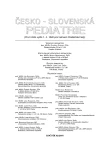Body Height and Body Mass Index in Patients with MODY2 Diabetes (Glucokinase Defect) in Childhood and Adulthood – a Pilot Study
Authors:
J. Lebl 1,2; Š. Průhová 1,2; O. Cinek 1; Z. Šumník 1; L. Gonsorčíková 1,2; Česká Skupina Pro Výzkum Mody Diabetu
Authors‘ workplace:
Pediatrická klinika UK 2. LF a FN Motol, Praha
přednosta prof. MUDr. J. Lebl, CSc.
1; Klinika dětí a dorostu UK 3. LF a FN Královské Vinohrady, Praha
přednosta doc. MUDr. F. Votava, Ph. D.
2
Published in:
Čes-slov Pediat 2007; 62 (9): 534-539.
Category:
Original Papers
Overview
Glucokinase plays a key role in the beta-cell glucose sensing. Mutations of the glucokinase gene (GCK) lead to chronic mild hyperglycemia (MODY2 phenotype). The study was aimed to study the auxological phenotype of GCK mutation carriers, including the intrauterine and postnatal growth and body mass index (BMI).
Birth weight, actual body height and BMI were analyzed in 43 GCK mutation carriers (M:F 24:19, age 1–58 years, median 18) in comparison with their 43 unaffected first-degree relatives (M:F 16:27, age 5–67 years, median 37) from 19 families. Auxological data were expressed as standard deviation score (SDS) of population standards in subjects aged 1-18 years; in adults, BMI was calculated in absolute value and body height as SDS compared to the age 18-19 years. Results are given as mean +/- SD.
Birth weight:
Whereas healthy offspring of unaffected mothers within the study population (n=12) had birth weight 3226±411 g, fetal MODY2 (n=14) led to a loss of 180 g (3045±311 g) and maternal MODY2 (n=3) to a gain of nearly 1300 g (4517±104 g). Both fetal and maternal MODY2 partly compensated for the birth weight (3610±244 g; p<0.0001, ANOVA).
Childhood and adolescence:
MODY2 patients (n=23, mean age 12.6 years) had similar BMI but tended to be smaller (height-SDS -0.03±1.26) compared to their first-degree relatives (n=23, mean age 12.9 years, height-SDS 0.78±0.89; p=0.058).
Adulthood:
The adult height-SDS did not differ between patients and controls. However, BMI in MODY2 adults (n=20, mean age 36.2 years) tended to be lower (24.6±3.3 kg/m2) than in controls (n=25, mean age 41.7 years, BMI 26.6±3.7 kg/m2; p=0.06).
GCK mutations in fetuses of healthy mothers induce intrauterine growth retardation, whereas healthy fetuses of mothers with MODY2 are born hypertrophic. Children and adolescents with MODY2 tend to be growth retarded if compared to their healthy first-degree relatives. Body height of adults with MODY2 is normal but their BMI tends to be lower in comparison to their first-degree relatives.
Key words:
MODY2, glucokinase, growth, body height, body mass index
Labels
Neonatology Paediatrics General practitioner for children and adolescentsArticle was published in
Czech-Slovak Pediatrics

2007 Issue 9
Most read in this issue
- Infection with Bacteria Pseudomonas aeruginosa in Patients with Cystic Fibrosis Diagnostics Possibilities and Clinical Outcomes of a Three-Year Study
- Disorders of Hemostasis in Newborns
- Unstable Hemoglobin Variants in Children of the Czech and Slovak Population
- Program of Hematopoietic Stem Cell Transplantation in Children at Department of Pediatric Hematology and Oncology, University Hospital Motol – from Fetal Liver to Cord Blood
